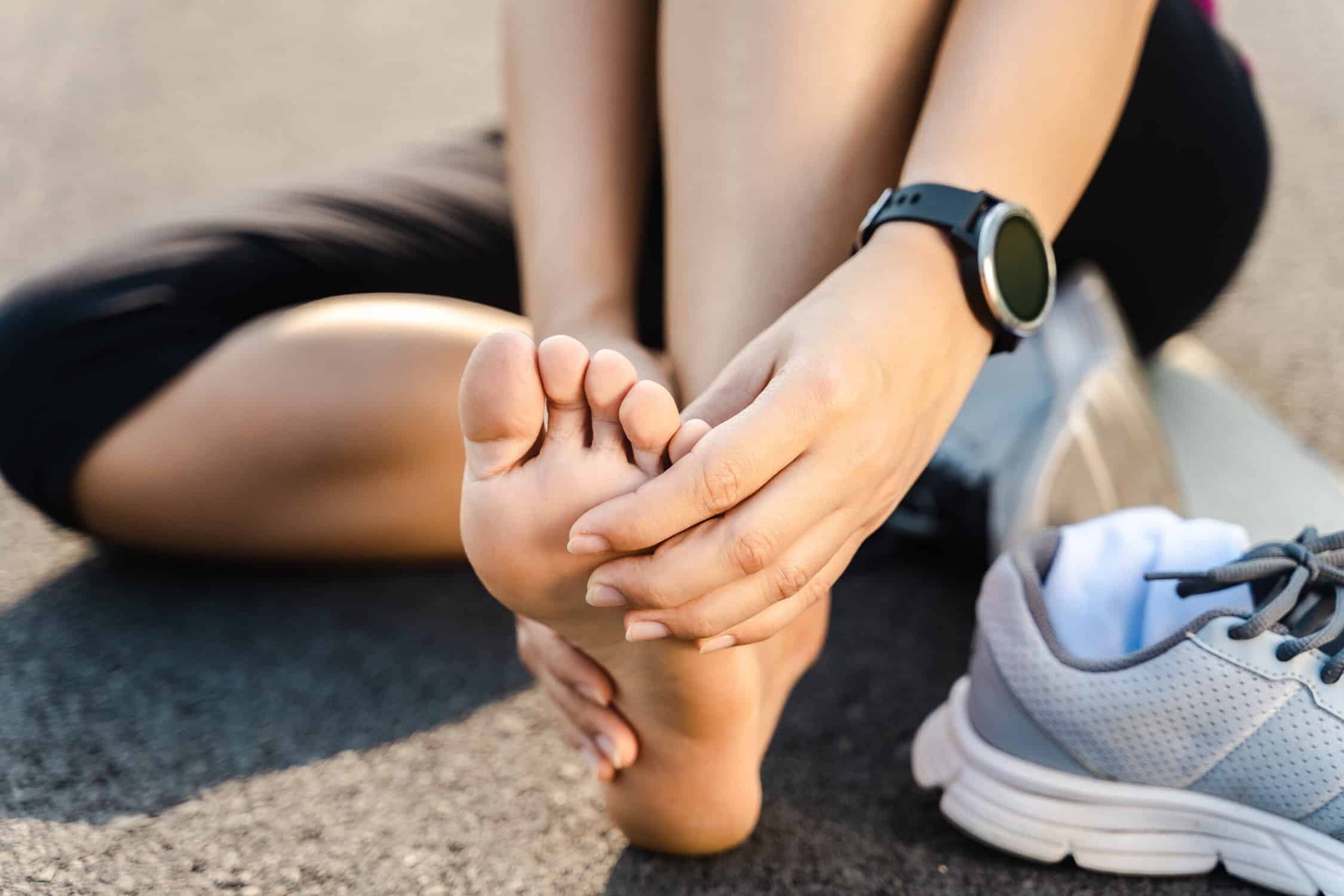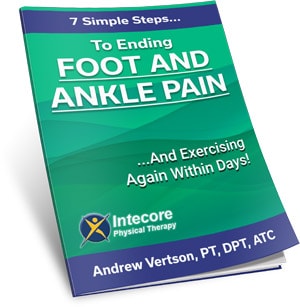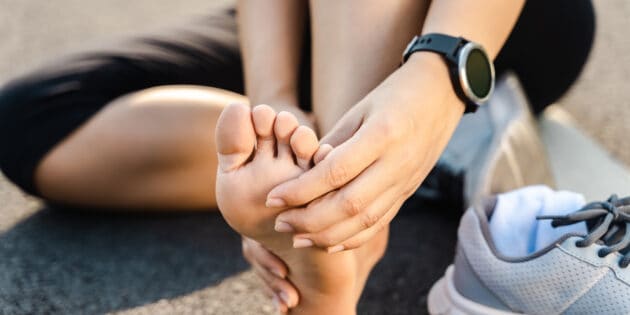
Picture this: It’s a gorgeous, sunny day outside. You lace up your favorite walking shoes, eager to enjoy a leisurely stroll through the park. But when you start walking a familiar, unwelcome sensation creeps into your feet — pain. What should be a relaxing, enjoyable activity quickly turns into a struggle, with each step becoming more uncomfortable than the last.
As the owner of a physical therapy clinic, I’ve encountered numerous clients who have experienced this. Foot pain when walking is a widespread issue, affecting people of all ages and walks of life. In fact, a study published in the Journal of Foot and Ankle Research suggests that approximately 24% of people over the age of 45 experience some form of foot pain. This discomfort can range from a mild annoyance to a debilitating condition that hampers daily activities.
In this blog, we’ll explore the common causes of foot pain when walking and provide five effective strategies to alleviate this discomfort. Whether you’re an avid walker, a weekend warrior, or someone who’s just trying to get through the day without pain, these tips can help you put your best foot forward — quite literally! Let’s dive in and discover how you can walk your way to comfort and enjoy those sunny day strolls again.
More Posts Like This From Intecore:
Radiculopathy vs Neuropathy: What’s the Difference?
Tips to Avoid Foot and Ankle Pain During the Holiday Shopping Season
Do The Shoes You Wear For Running Actually Matter?
Table of Contents
1. Proper Footwear
Choose Shoes with Adequate Support
The foundation of foot comfort starts with the right footwear. Shoes that provide proper support can significantly reduce foot pain. When selecting shoes, look for a pair that offers good arch support, a cushioned sole, and enough room to wiggle your toes.
For those who need extra support, orthotic inserts can be a game-changer. Custom orthotics, designed to fit the unique contours of your feet, can distribute pressure evenly and alleviate pain. A study in the Journal of Foot and Ankle Research found that orthotic devices can effectively reduce foot pain for many people, especially those with conditions like flat feet or plantar fasciitis. To find out more about Orthotics – get in touch with us here.
It’s also crucial to replace your shoes regularly. Worn-out shoes lose their ability to provide adequate support, leading to increased foot strain. It’s recommend that you replace walking or running shoes every 300 to 500 miles to ensure proper foot health.
2. Warm-up and Stretch
Perform dynamic warm-up exercises
Before you start walking, a proper warm-up can prepare your muscles and reduce the risk of pain. Dynamic exercises, such as ankle circles or toe taps, increase blood flow to your feet and improve flexibility. Warm-ups enhance muscular performance and decrease the likelihood of injuries.
Tight calf muscles can contribute to foot pain. Regular stretching can alleviate this tension. Simple calf stretches, like the wall push or downward dog yoga pose, can be effective. Holding each stretch for at least 30 seconds and repeating them several times will give you the best results.
The plantar fascia, a band of tissue running along the bottom of your foot, can be a source of pain when inflamed. Gentle stretching of this area can provide relief. A popular method involves rolling a tennis ball or a frozen water bottle under your foot. This not only stretches the plantar fascia but also provides a soothing massage effect.
3. Practice Good Walking Technique
Maintain Proper Posture
Good posture is crucial for reducing foot pain. Keeping your body aligned can distribute your weight more evenly across your feet. The American Chiropractic Association recommends standing tall, with shoulders back and relaxed, and ensuring your weight is evenly balanced on both feet. This reduces undue stress on any single part of the foot.
Taking shorter strides can lessen the impact on your feet. Overstriding can lead to excessive force on the heel and forefoot, exacerbating pain. Focus on a shorter, more natural stride to promote a gentler foot landing, which can reduce strain on your feet and your joints.
Changing how your foot hits the ground can make a significant difference. Landing on the midfoot, rather than the heel or toes, allows for better shock absorption and distribution of pressure. This technique, is great both runners and walkers.
4. Modify Walking Surfaces
Avoid Uneven or Hard Surfaces
The surface you walk on can impact your foot health. Walking on hard or uneven surfaces like concrete can increase the stress on your feet. Whenever possible, choose softer, more forgiving surfaces.
Cushioned insoles or shoes can provide additional shock absorption, reducing the impact on your feet. This extra cushioning can be especially helpful if you frequently walk on harder surfaces.
If accessible, walking on natural surfaces like grass or trails can be more comfortable for your feet. These surfaces are generally softer and more yielding than concrete, offering a natural cushion. A study in the Journal of Experimental Biology found that walking on softer ground can reduce the amount of energy your body uses, indicating a lesser impact on your feet.
5. Rest and Recovery
Listen to Your Body
One of the most important ways to manage foot pain is to listen to what your body is telling you. If you’re experiencing pain, it’s a sign that you need to slow down or modify your activities. Ignoring the signals from the body can lead to more severe injuries.
Incorporating regular breaks into your walking routine can prevent overuse injuries. This doesn’t mean you need to cut down your overall activity significantly; instead, it’s about giving your feet time to rest and recover, and alleviate the pressure on your feet.
Foot massages and ice baths can be excellent for recovery. Massages increase circulation and can help alleviate muscle tightness, while ice baths can reduce inflammation and numb pain. According to a study in the Journal of Physiological Anthropology, regular foot massages can significantly reduce foot pain and improve overall foot health.
Ready To Get Help With Physical Therapy?
Dealing with foot pain when walking can be challenging, but with these five strategies, you can find relief and enjoy your walks pain-free. From choosing the right footwear to practicing good walking techniques and ensuring adequate rest and recovery, each step is crucial in maintaining healthy feet.
Remember, if your foot pain persists or worsens, it’s important to consult with a healthcare professional. As a physical therapy clinic owner, I’ve seen firsthand how personalized care can make a significant difference in managing and overcoming foot pain. Don’t let foot pain hold you back – with the right approach, you can step out in comfort and confidence!
f you need some help and want to find out if physical therapy is right for you – we’re here for you.
Simply complete this quick form and tell us about what’s going on and our team will be in touch: https://intecorept.com/inquire/ Or, gives us a call at: 949-569-5847
Or, you can download our FREE foot and ankle pain guide which shares with you 7 simple steps to ending foot and ankle pain – click here to download it!

- Why Regular Body Maintenance is Crucial for Long-Term Health - April 21, 2024
- 3 Things Aggravate Knee Pain After Biking and How to Ease It - April 14, 2024
- Runners Knee Stretches: Top 5 Stretches Every Runner Needs to Know - April 7, 2024














